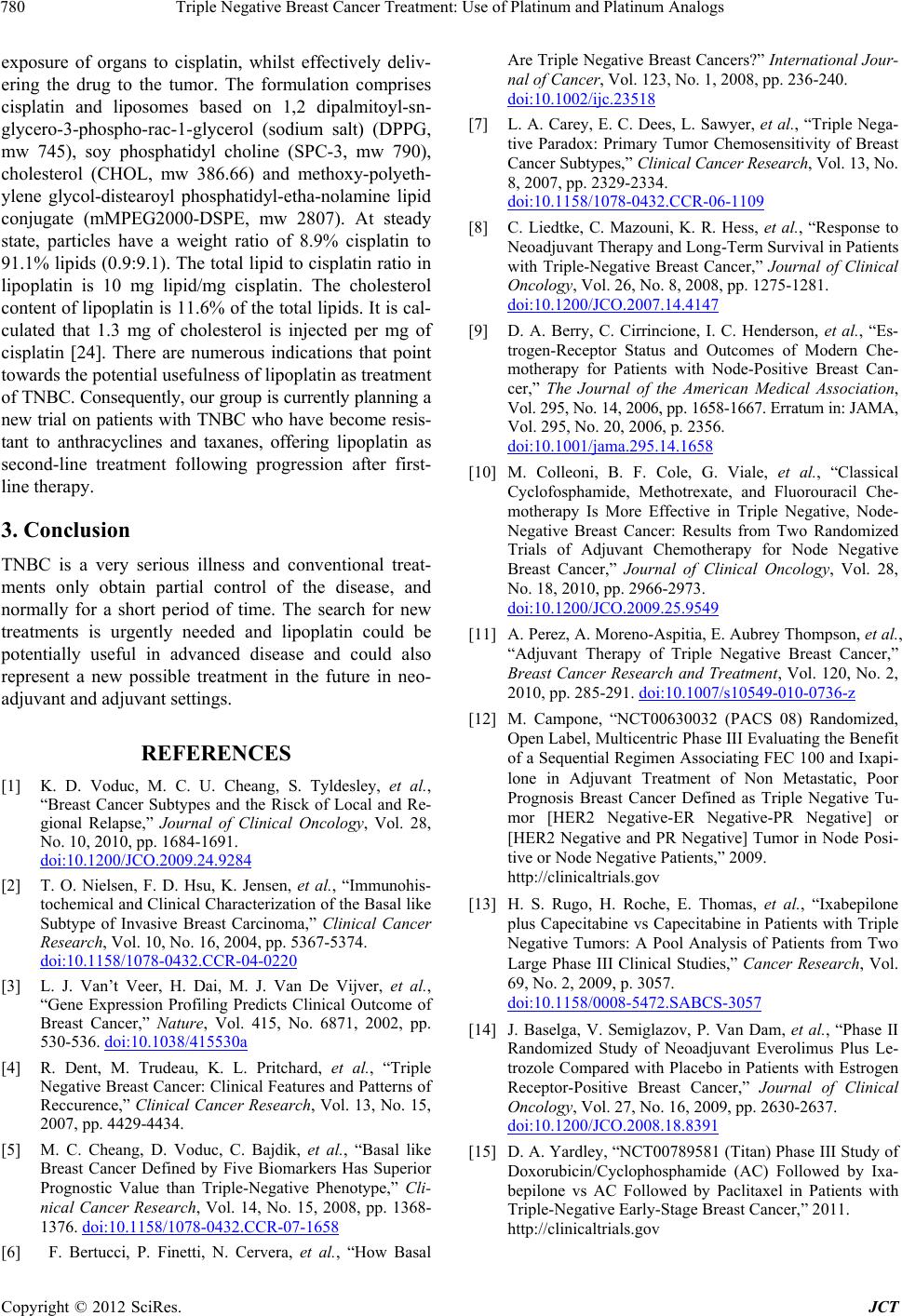
Triple Negative Breast Cancer Treatment: Use of Platinum and Platinum Analogs
780
exposure of organs to cisplatin, whilst effectively deliv-
ering the drug to the tumor. The formulation comprises
cisplatin and liposomes based on 1,2 dipalmitoyl-sn-
glycero-3-phospho-rac-1-glycerol (sodium salt) (DPPG,
mw 745), soy phosphatidyl choline (SPC-3, mw 790),
cholesterol (CHOL, mw 386.66) and methoxy-polyeth-
ylene glycol-distearoyl phosphatidyl-etha-nolamine lipid
conjugate (mMPEG2000-DSPE, mw 2807). At steady
state, particles have a weight ratio of 8.9% cisplatin to
91.1% lipids (0.9:9 .1). The total lipid to cisplatin ratio in
lipoplatin is 10 mg lipid/mg cisplatin. The cholesterol
content of lipoplatin is 11.6% of the total lipids. It is cal-
culated that 1.3 mg of cholesterol is injected per mg of
cisplatin [24]. There are numerous indications that point
towards the potential usefulness of lipoplatin as treatment
of TNBC. Consequently, our group is currently planning a
new trial on patients with TNBC who have become resis-
tant to anthracyclines and taxanes, offering lipoplatin as
second-line treatment following progression after first-
line therapy.
3. Conclusion
TNBC is a very serious illness and conventional treat-
ments only obtain partial control of the disease, and
normally for a short period of time. The search for new
treatments is urgently needed and lipoplatin could be
potentially useful in advanced disease and could also
represent a new possible treatment in the future in neo-
adjuvant and ad juvant settings.
REFERENCES
[1] K. D. Voduc, M. C. U. Cheang, S. Tyldesley, et al.,
“Breast Cancer Subtypes and the Risck of Local and Re-
gional Relapse,” Journal of Clinical Oncology, Vol. 28,
No. 10, 2010, pp. 1684-1691.
doi:10.1200/JCO.2009.24.9284
[2] T. O. Nielsen, F. D. Hsu, K. Jensen, et al., “Immunohis-
tochemical and Clinical Characterization of the Basal like
Subtype of Invasive Breast Carcinoma,” Clinical Cancer
Research, Vol. 10, No. 16, 2004, pp. 5367-5374.
doi:10.1158/1078-0432.CCR-04-0220
[3] L. J. Van’t Veer, H. Dai, M. J. Van De Vijver, et al.,
“Gene Expression Profiling Predicts Clinical Outcome of
Breast Cancer,” Nature, Vol. 415, No. 6871, 2002, pp.
530-536. doi:10.1038/415530a
[4] R. Dent, M. Trudeau, K. L. Pritchard, et al., “Triple
Negative Breast Cancer: Clinical Features and Patterns of
Reccurence,” Clinical Cancer Research, Vol. 13, No. 15,
2007, pp. 4429-4434.
[5] M. C. Cheang, D. Voduc, C. Bajdik, et al., “Basal like
Breast Cancer Defined by Five Biomarkers Has Superior
Prognostic Value than Triple-Negative Phenotype,” Cli-
nical Cancer Research, Vol. 14, No. 15, 2008, pp. 1368-
1376. doi:10.1158/1078-0432.CCR-07-1658
[6] F. Bertucci, P. Finetti, N. Cervera, et al., “How Basal
Are Triple Negative Breast Cancers?” International Jour-
nal of Cancer, Vol. 123, No. 1, 2008, pp. 236-240.
doi:10.1002/ijc.23518
[7] L. A. Carey, E. C. Dees, L. Sawyer, et al., “Triple Nega-
tive Paradox: Primary Tumor Chemosensitivity of Breast
Cancer Subtypes,” Cli n ical Cancer Research, Vol. 13, No .
8, 2007, pp. 2329-2334.
doi:10.1158/1078-0432.CCR-06-1109
[8] C. Liedtke, C. Mazouni, K. R. Hess, et al., “Response to
Neoadjuvan t Therapy and L ong-Term Survival in Patients
with Triple-Negative Breast Cancer,” Journal of Clinical
Oncology, Vol. 26, No. 8, 2008, pp. 1275-1281.
doi:10.1200/JCO.2007.14.4147
[9] D. A. Berry, C. Cirrincione, I. C. Henderson, et al., “Es-
trogen-Receptor Status and Outcomes of Modern Che-
motherapy for Patients with Node-Positive Breast Can-
cer,” The Journal of the American Medical Association,
Vol. 295, No. 14, 2006, pp. 1658-1667. Erratum in: JAMA,
Vol. 295, No. 20, 2006, p. 2356.
doi:10.1001/jama.295.14.1658
[10] M. Colleoni, B. F. Cole, G. Viale, et al., “Classical
Cyclofosphamide, Methotrexate, and Fluorouracil Che-
motherapy Is More Effective in Triple Negative, Node-
Negative Breast Cancer: Results from Two Randomized
Trials of Adjuvant Chemotherapy for Node Negative
Breast Cancer,” Journal of Clinical Oncology, Vol. 28,
No. 18, 2010, pp. 2966-2973.
doi:10.1200/JCO.2009.25.9549
[11] A. Perez, A. Moreno-Aspitia, E. Aubrey Thompson, et al.,
“Adjuvant Therapy of Triple Negative Breast Cancer,”
Breast Cancer Research and Treatment, Vol. 120, No. 2,
2010, pp. 285-291. doi:10.1007/s10549-010-0736-z
[12] M. Campone, “NCT00630032 (PACS 08) Randomized,
Open Label, Multicentric Phase III Evaluating the Benefit
of a Sequential Regimen Associating FEC 100 and Ixapi-
lone in Adjuvant Treatment of Non Metastatic, Poor
Prognosis Breast Cancer Defined as Triple Negative Tu-
mor [HER2 Negative-ER Negative-PR Negative] or
[HER2 Negative and PR Negative] Tumor in Node Posi-
tive or Node Negative Patients,” 2009.
http://clinicaltrials.gov
[13] H. S. Rugo, H. Roche, E. Thomas, et al., “Ixabepilone
plus Capecitabine vs Capecitabine in Patients with Triple
Negative Tumors: A Pool Analysis of Patients from Two
Large Phase III Clinical Studies,” Cancer Research, Vol.
69, No. 2, 2009, p. 3057.
doi:10.1158/0008-5472.SABCS-3057
[14] J. Baselga, V. Semiglazov, P. Van Dam, et al., “Phase II
Randomized Study of Neoadjuvant Everolimus Plus Le-
trozole Compared with Placebo in Patients with Estrogen
Receptor-Positive Breast Cancer,” Journal of Clinical
Oncology, Vol. 27, No. 16, 2009, pp. 2630-2637.
doi:10.1200/JCO.2008.18.8391
[15] D. A. Yardley, “NCT00789581 (Titan) Phase III Study of
Doxorubicin/Cyclophosphamide (AC) Followed by Ixa-
bepilone vs AC Followed by Paclitaxel in Patients with
Triple-Negative Early-Stage Breast Cancer,” 2011.
http://clinicaltrials.gov
Copyright © 2012 SciRes. JCT